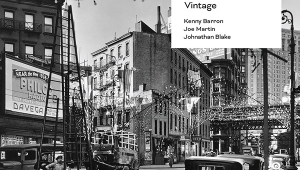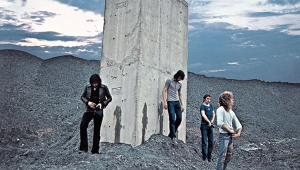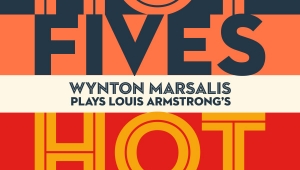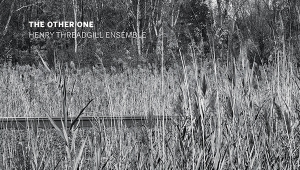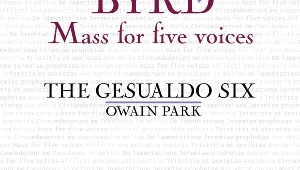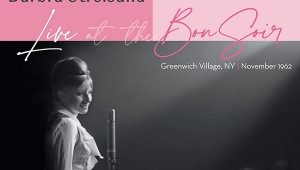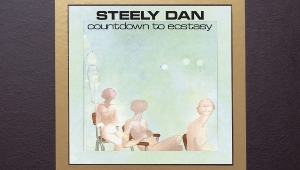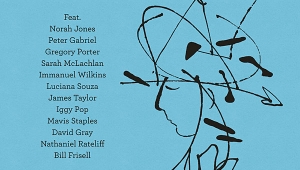| Columns Retired Columns & Blogs |
Recordings of December 1996: Portraits & The Mercury Blues 'n' Rhythm Story, 1945-1955
EMMYLOU HARRIS: Portraits
Reprise Archives 45308-2 (3 CDs only). Gregg Geller, prod.; Keith Blake, eng.; Jo Motta, project coordinator. 1996. TT: 3:42:11
Reprise Archives 45308-2 (3 CDs only). Gregg Geller, prod.; Keith Blake, eng.; Jo Motta, project coordinator. 1996. TT: 3:42:11
VARIOUS: The Mercury Blues 'n' Rhythm Story, 1945-1955
Mercury 314 528 292-2 (8 CDs only). Bill Levenson, exec prod.; Jim Fishel, Barbara Lynn Micale, prods.; Suha Gur, eng. 1996. TT: 8:31:05
The rush to make a CD boxed set for every artist and genre is in the home stretch. Over the past five or six Christmas seasons, labels have nearly exhausted all the obvious choices. Instead of who's been boxed, the question now is who's left. Still, many of the remaining candidates are sweet: Gram Parsons, Bruce Springsteen (the live box is only that), Sun Ra, Sonny Rollins, a comprehensive George Jones, Joni Mitchell, Van Morrison, Nirvana. And then there's every true believer's dream: the Tom Waits box. Of course, that will be released on the Tuesday before Armageddon, which means no one will ever hear it.
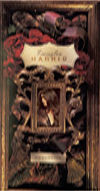 The Emmylou Harris and Mercury boxes—deadlocked in a tie for Stereophile's Recording of the Month—fill two yawning holes in the boxed-set oeuvre. The Emmylou set has been long delayed, long awaited, and is, of course, very wonderful. Anyone who knows her music knows that nearly every track here is worth a listen. Between 1975 and 1984, Harris and husband/producer Brian Ahearn put together an astonishing string of eight consistently gorgeous albums that still rank among the finest artifacts in the WEA catalog. Every element of those discs clicked—from the sharply focused arrangements, to the synergy between great players like James Burton, Glen D. Hardin, and Emory Gordy, to the incredible alchemy of material covered. Those albums covered a wide scope, but their top criterion was a classy tune, no matter what the genre. In the middle of it all was Harris's unmistakable soprano, which could growl or whisper, or soar as fine and fragile as spun glass.
The Emmylou Harris and Mercury boxes—deadlocked in a tie for Stereophile's Recording of the Month—fill two yawning holes in the boxed-set oeuvre. The Emmylou set has been long delayed, long awaited, and is, of course, very wonderful. Anyone who knows her music knows that nearly every track here is worth a listen. Between 1975 and 1984, Harris and husband/producer Brian Ahearn put together an astonishing string of eight consistently gorgeous albums that still rank among the finest artifacts in the WEA catalog. Every element of those discs clicked—from the sharply focused arrangements, to the synergy between great players like James Burton, Glen D. Hardin, and Emory Gordy, to the incredible alchemy of material covered. Those albums covered a wide scope, but their top criterion was a classy tune, no matter what the genre. In the middle of it all was Harris's unmistakable soprano, which could growl or whisper, or soar as fine and fragile as spun glass.
The 61 tracks in this three-disc box will more than satisfy anyone looking for a comprehensive greatest-hits collection. For more serious fans, Portraits is a classic example of a label having its cake and eating it too. Either that or someone, possibly Harris, had a bizarre notion of what to include and what to leave out. (I suspect the former theory.) After all, the trick behind compiling a boxed set is to include enough good material and rarities to make it irresistible, but not so much as to kill off sales of the individual albums still in the catalog. In the case of Portraits, Reprise had it easy: For nearly a decade, Harris cut nothing but winners, so it was impossible to leave out a classic track.
On the gotta-have-it side are four beautifully remastered Gram Parsons/Emmylou duets (all previously released), and six unreleased tracks—more than enough to force the veterans in Emmylou's loyal army to make a mantra of their plastic's expiration date. When it comes to inspiring whiney record-geeks (like me) to also buy individual discs, there's only one track from the underrated White Shoes album. And if you were hoping to hear "Bluebird Wine" from Pieces of the Sky, "Even Cowgirls Get the Blues" from Blue Kentucky Girl, or "Amarillo" from Elite Hotel, they're right where they've always been: on the original albums.
To be fair, another reason to own this set is the improved sound, particularly on the early material; sonics on the original releases, while not horrible, were not models of clarity. There are also a number of interesting if previously released tracks from Harris side projects like Trio (with Linda Ronstadt and Dolly Parton) and Partners (Flaco Jimenez's duet record), and an obscure A&M record called The Legend of Jesse James. Colin Escott's liner notes are properly worshipful and filled with good detail, and the [page?] booklet reproduces one photo of a very young Emmylou that doesn't seem to have been published before. Overall, the packaging is not excessively grand, a point that will not escape Emmylou fanatics. Sinatra gets a leather suitcase; Emmylou gets a three-disc box with a stapled booklet. Hmmm.
The other worthy contender this month doesn't have that problem. Although it's not bound in glove leather, Mercury's monster eight-disc R&B box is impressively annotated, remastered, and packaged. The original paintings of R&B artists by Matt O'Neill that grace the cover of each two-disc jewelbox are especially good. Some of this material was previously reissued around the dawn of CDs on the two-disc Mercury Rhythm & Blues (1946-1962). I assume (it isn't explained in the 86-page booklet) that the title has been reversed for this effort on the grounds that it contains more straight blues than R&B. Although Mercury's slate of artists was never as big or as influential as the Atlantic R&B roster, it did include middle-level stars like T-Bone Walker, Dinah Washington, Big Bill Broonzy, Sunnyland Slim, Memphis Slim, Robert Lockwood Jr., Jay McShann, Lightnin' Hopkins, Johnny Otis, and Eddie "Mr. Cleanhead" Vinson, all of whom are represented here. One very puzzling omission is Louis Jordan, who still has a disc in print in the Mercury catalog.
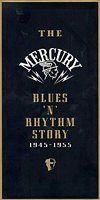 The box's bounty is organized geographically, with two discs each for the East Coast, Southwest, Midwest, and West Coast. The Midwest pair opens with a swinging cut by the Four Jumps of Jive, recorded a little over a month after VJ-Day. Other highlights include a strong collection of straight blues by Big Bill Broonzy; an unusual calypso beat honker called "I'm A Good Rockin' Daddy" by the long-forgotten Ray Snead; and a pair of superb risqué numbers by Dinah Washington. When you listen to these thinly veiled references to sex, it's hard not to ponder the cultural chasm between Loretta Lynn's "Don't Come Home a-Drinkin' (With Lovin' On Your Mind)" and such Washington lyrics as "Listen here all you women, every time you want to be wooed / take your man down to the nearest juice joint and get him nice and stewed" (from "Joy Juice").
The box's bounty is organized geographically, with two discs each for the East Coast, Southwest, Midwest, and West Coast. The Midwest pair opens with a swinging cut by the Four Jumps of Jive, recorded a little over a month after VJ-Day. Other highlights include a strong collection of straight blues by Big Bill Broonzy; an unusual calypso beat honker called "I'm A Good Rockin' Daddy" by the long-forgotten Ray Snead; and a pair of superb risqué numbers by Dinah Washington. When you listen to these thinly veiled references to sex, it's hard not to ponder the cultural chasm between Loretta Lynn's "Don't Come Home a-Drinkin' (With Lovin' On Your Mind)" and such Washington lyrics as "Listen here all you women, every time you want to be wooed / take your man down to the nearest juice joint and get him nice and stewed" (from "Joy Juice").
The Southwest discs (Vols.3 and 4) are highlighted by 18 tracks recorded in New Orleans by, among others, the obscure Alma "The Lollipop Mama" Mondy, Roy Byrd (before he called himself Professor Longhair), and an unreleased track by one-session wonder Hosie Dwine Craven. The second disc of the pair comes from sessions held in Houston, and contains a half dozen typically high-quality Lightnin' Hopkins acoustic tunes, along with the sleeper, "Papa Said Yes, Mama Said No, No, No" by blues shouter Lee Graves.
Like the Southwest duo, the West Coast discs open with a batch of bluesy big band numbers, this time by Jay McShann. The L.A. scene—a stylistic extension of the Texas small big band accompanying a blues shouter—was dominated vocally by Charles Brown, whose smooth style is aped by nearly every vocalist on these two discs. The contributions of the king of West Coast R&B, Johnny Otis, are represented by a generous nine cuts.
A number of players who later made names for themselves in jazz are present on these sessions: tenor player Plas Johnson, altoist Marshall Royal, trumpeter Art Farmer—and John Coltrane, who adds sax fills to crooner Billy Valentine's "Beer-Drinking Baby." The final cut on this set is Rollee McGill's "Rhythm Rockin' Blues," recorded in 1955 and a perfect example of how rhythm and blues inspired rock and roll.
The last two volumes document the surprisingly varied East Coast scene, and are a fitting conclusion to this rewarding chunk of irrepressible music. Cleanhead Vinson is back, as is Dinah Washington for a killer half dozen that includes the brassy "Fine Fine Daddy." As the seat of all that is lustful, lips are a repeated motif throughout this pair of raucous discs, with the Trenier Twins' delightful "Hey, Sister Lucy! (What makes your lips so juicy...)" followed by Buddy Johnson's "Shut Your Big Mouth (Girl)," which opens with "Your lips are flapping like two blankets in a stiff breeze."
From there, things get ever more frenzied. Dinah Washington wades in with the self-explanatory "Short John," the companion piece to "Long John Blues" (found on the first Midwest disc). Then Screaming Jay Hawkins takes over and cuts loose as only he can on "What That Is," one of the wildest R&B numbers ever waxed.
As is the case with virtually all R&B reissues, the sound here varies from sparkling to scratchy, depending upon whether the source was an acetate or a 78. In general, though, nothing is unlistenable, and in some cases the sonic restoration is miraculous. Although it doesn't possess the firepower of the first Stax boxed set (what does?), this formidable mountain of R&B is still the kind of deep well you'll want to sip from again and again.—Robert Baird
- Log in or register to post comments


